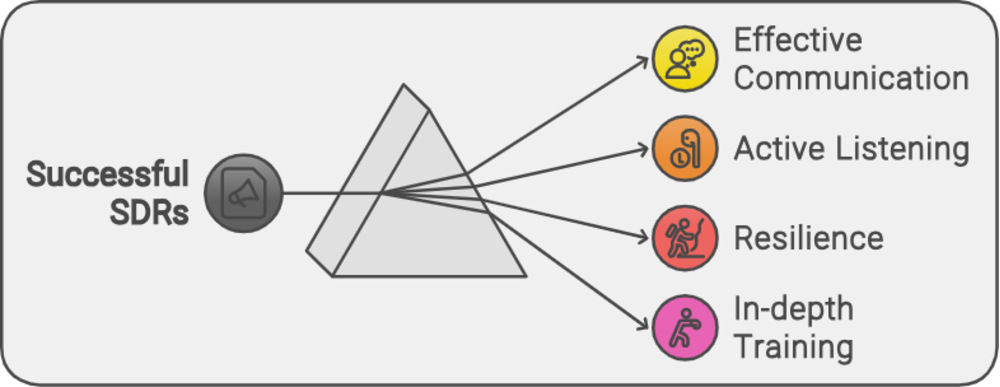Sales development representatives are salespeople who specialize in prospecting and lead generation. They’re usually responsible for making the first contact with prospective customers, which often takes the form of phone calls or emails.
Sales Development Representatives typically work for larger companies that offer multiple products or services, meaning they can target prospects by industry, location, company size, and other criteria. Some common titles include “sales engineer,” “business development representative,” and “account executive.” Unlike some other types of salespeople who sell directly to consumers (e.g., door-to-door sales), SDRs generally don’t interact with end users–instead they focus on finding potential clients within an organization to bring into the fold.
SDRs can be employed by several different types of businesses, from smaller companies with only a handful of employees to larger ones with hundreds or even thousands.
Who is this article for? If your company is hiring sales development reps, you may find this knowledge useful in helping them understand what SDRs do and how they fit into the business. If you’re an SDR, this can help you understand what’s expected of you and how your job fits into the organization as a whole.
What is a Sales Development Rep (SDR)?
Sales Development Representatives (SDRs) are the first point of contact for many sales teams. They are responsible for identifying and qualifying potential customers, as well as building relationships with potential buyers.
SDRs are responsible for cold-calling and emailing potential clients to see if they would be interested in learning more about a company’s products and services.
The typical day in the life of an SDR includes a lot of outreach, whether through phone calls, emails, or social media. They spend a lot of time reaching out to potential customers and identifying those who might be interested in what their company has to offer.
Because of their active role in the discovery, SDRs are often involved in success closes. They work with customers to discover how they can best solve problems and identify the best solution for them. SDRs then work with sales staff to finalize any necessary paperwork before closing.
Sales representatives who are looking to further their careers typically begin as SDRs. They can then move into other jobs within the field, including territory sales representatives and account managers.
Sellers looking to become an SDR should keep in mind that this position requires a lot of outreach, often making phone calls or sending emails for long periods every day. This job is ideal for someone who enjoys listening and speaking to people and is motivated by the idea of helping others.
What are the skills and qualifications for an SDR role?
Sales Development Representatives (SDRs) are responsible for developing new business opportunities through prospecting and qualifying leads. They play an essential role in a company’s sales process by identifying potential customers and creating interest in a product or service. SDRs should have excellent communication skills, be able to solve problems, and articulate ideas.
They should also be comfortable working with people and be able to build relationships. Qualifications for an SDR role vary depending on the company, but some standard requirements include a college degree, previous sales experience, and knowledge of the company’s products or services. It also includes strong communication skills, problem-solving skills, and the ability to articulate ideas. They should also be comfortable working with people and be able to establish trust.

What skills do successful SDRs have?
Successful SDRs are incredibly effective communicators, especially on the phone. They’re able to move a conversation quickly from small talk to business and back again in a matter of minutes. Sales reps must be good listeners and be adept at picking up on the subtle nuances in tone and body language that can help determine who’s a good fit for their product.
Sellers should also be able to pick up quickly on the prospect’s tone, whether they are excited about the prospect, skeptical, or completely disinterested. This means listening carefully to what prospects say and paying attention to their body language.
If you’re thinking of applying for an SDR role, you should be able to demonstrate your ability to handle rejection. Even the most experienced sales reps occasionally get turned down on cold calls. Successful SDRs are resilient and not discouraged easily by what others think of them or their ideas.

Sellers interested in becoming successful SDRs should consider joining a company that provides in-depth training. This is an excellent way to learn the ins and outs of sales, including qualifying leads, customer relations, upselling/cross-selling techniques, and much more.
What are some challenges faced by SDRs?
Selling over the phone can be extremely challenging because it requires sellers to strike a balance between demonstrating their expertise on the product or service they are selling while remaining flexible enough to adapt to any objections. This requires excellent communication skills and the ability to think quickly on one’s feet.
Sales development representatives (SDRs) are vital for many sales teams. They bridge the gap between potential customers and the sales team by qualifying leads and building relationships. SDRs are typically responsible for the following tasks:
-
- Generating leads through research and networking
- Qualifying leads through phone calls, emails, or other forms of communication
- Building relationships with potential customers
- Collaborating with the sales team to follow up on qualified leads
One of the main challenges faced by SDRs is qualifying leads. This involves determining whether or not a lead is worth pursuing and whether or not they have the budget and need for the product or service being offered, and ensuring the lead is a legitimate opportunity. They need to identify the buying signals of potential buyers and determine whether or not they are a good fit for the company’s products or services. They also need to qualify the leads based on their budget, timeline, and authority.
SDRs also face the challenge of building relationships with potential customers. This requires empathy for the buyer and understanding their needs, which can be challenging to do over email or phone.
SDRs are also typically responsible for researching industry trends and events to find leads and maintaining an updated database of contacts they have spoken with recently. SDRs collaborate with the sales team to ensure all qualified leads flow through for a smooth and effective sales process.
How can you become a successful SDR salesperson?
The road to becoming a successful SDR salesperson is not an easy one. It takes a lot of hard work, determination, and resilience. However, if you are willing to put in the effort, here are some tips to help you on your journey.
First and foremost, it is important to understand what a sales development representative does. This will help you to better understand the role and the skills that are required for success. Secondly, make sure that you have the necessary qualifications and experience.
Finally, hone your skillset by practicing and learning from others. Be open to feedback and willing to learn from your mistakes.
Sales Development reps learn from their mistakes. They are constantly working to improve their skills and become more successful in their role. One of the best ways to learn is to reflect on your experiences and see what you can learn from them.

For example, they can learn how to qualify potential customers better, build better relationships with clients, and generate more leads. They can also learn what works and what doesn’t work for them, so they can continue to improve their sales process.
Mistakes are a valuable part of the learning process, and sales development reps should embrace them. By learning from their mistakes, SDRs can become more successful in their role and boost their sales performance.
What are the benefits of working as an SDR?
The benefits of working as an SDR are vast. Sales development reps are responsible for developing new leads and opportunities for their company by working with potential customers. They identify potential customers, qualify them, and create a plan to move them through the sales funnel. By doing this, they help increase sales and revenue for their company.
Another benefit of working as an SDR is that they have the opportunity to learn about the sales process. They learn how to identify customer needs, understand what solutions they need, and articulate those solutions to potential customers. This knowledge helps them when they transition into a role in sales.
SDRs also have the opportunity to work with a wide range of people. They develop relationships with current customers, potential customers, and sales reps. They must learn to work with many different types of people to help them move through the sales process.

What is the future of the Sales Development Rep role?
The future of the SDR role is bright. Sales development reps are an essential part of any sales team and play a vital role in the company’s success. They are responsible for developing new leads and opportunities for their company by working with potential customers.
SDRs are a great fit for many sales teams because they can work with people, solve problems, and articulate ideas. They are also responsible for researching industry trends and events to find leads and maintaining an updated database of contacts they have spoken with recently. This makes them an invaluable part of any sales organization.
Sales development reps are critical to the success of any company, and their role will only continue to grow in importance in the coming years. As a result, more and more companies are hiring SDRs to help with their sales process and increase revenue.
The perfect candidate for this job has excellent phone skills and is able to speak with poise and confidence when communicating with potential customers. They must be able to communicate accurately, understand customer needs, and add value to the sales process.
The role of an SDR is demanding and requires constant improvement for success. However, with the proper training, skillset, and work ethic, they can become one of the most important parts of any successful sales organization.
Conclusion
Sales Development Reps (SDRs) are the lifeblood of any sales organization. They play an important role in qualifying leads and getting them ready for the next stage of the sales process. SDRs should have excellent communication skills, be able to solve problems, and articulate ideas well.
The typical day for a sales development representative is always busy. They are constantly on the phone or emailing trying to qualify leads and get them ready for the next stage of the sales process. A lot of outreach via email and phone and working with other members of the sales team to help move deals through the pipeline. If you’re looking for a career in sales, consider becoming an SDR – it’s a great way to start your journey up the ladder to success.






